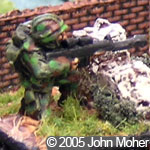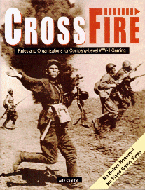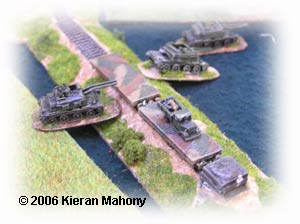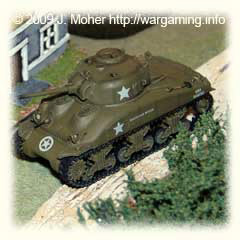
Date Played: 04 April 2009 11.00am NZDT (03 April 10.00pm GMT); 0630 WCFD Game Time.
Game Report by Errol Hooker (Umpire).
Table is 4′ x 4’ – the whole table has quite dense terrain all over it – woods, rough ground, hills, hedges and the like – plenty of sight blocks. Down the southern edge runs a river. Elsewhere are two buildings and a supply dump.
There must be plenty of cover for entering Americans, so that they do not get mown down just trying to walk onto the table – some of it contiguous with the table edge, and some sight-blocking features not touching the edge, so that it is possible to get onto the table and be out of LOS of the Germans.
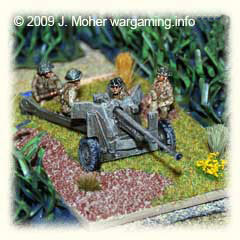
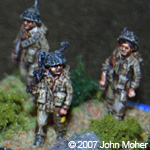 Kieran and I had arranged to play a “Hit The Dirt” scenario with Errol Hooker (who was coming down from Whangarei for the day), so we selected ‘Scottish Corridor’, as we had played it previously and knew it was a suitable medium-sized scenario that had a little of everything (Tanks, Infantry, Indirect Fire, etc). I had also recently started work on some new terrain (3D fields and Bocage style hedges) so we had slightly better terrain for it than the previous occasion. I also got the ridge right this time with the reclining slope on the back of the ridge, and we endeavoured to get the table to even more closely match the map. Unfortunately Errol couldn’t make it at short notice, but Kieran and I continued on, and we had another Auckland Wargamer (Grant Brown) present as an observer interested in Crossfire.
Kieran and I had arranged to play a “Hit The Dirt” scenario with Errol Hooker (who was coming down from Whangarei for the day), so we selected ‘Scottish Corridor’, as we had played it previously and knew it was a suitable medium-sized scenario that had a little of everything (Tanks, Infantry, Indirect Fire, etc). I had also recently started work on some new terrain (3D fields and Bocage style hedges) so we had slightly better terrain for it than the previous occasion. I also got the ridge right this time with the reclining slope on the back of the ridge, and we endeavoured to get the table to even more closely match the map. Unfortunately Errol couldn’t make it at short notice, but Kieran and I continued on, and we had another Auckland Wargamer (Grant Brown) present as an observer interested in Crossfire.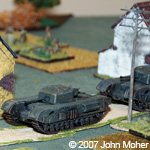 Kieran and I lined up yet another “Hit The Dirt” scenario, Highway 120 looked interesting, but my US & Italian forces were either still waiting to be based up or only part painted. So to get round the issue we transplanted the scenario to a later period – Summer 1944 in Italy after the fall of Rome… The Americans would be replaced by British Infantry with Churchills from a supporting Tank Brigade, and the Italians replaced with Germans. Otherwise the OOB was pretty close to what was in Hit the Dirt. Kieran would command the German Defenders, and I the British Attackers.
Kieran and I lined up yet another “Hit The Dirt” scenario, Highway 120 looked interesting, but my US & Italian forces were either still waiting to be based up or only part painted. So to get round the issue we transplanted the scenario to a later period – Summer 1944 in Italy after the fall of Rome… The Americans would be replaced by British Infantry with Churchills from a supporting Tank Brigade, and the Italians replaced with Germans. Otherwise the OOB was pretty close to what was in Hit the Dirt. Kieran would command the German Defenders, and I the British Attackers.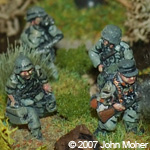 Kieran and I decided to play yet another “Hit The Dirt” scenario, so we selected ‘Scottish Corridor’, as a suitable medium-sized scenario that matched our available forces on the day. Before going further please note that all hedge lines and such in the scenario are Bocage, however in the photos we have only used normal Hedges and Lichen to represent these, so bear that in mind when viewing. Note we also got the map slightly wrong in the North-East corner (top right), we misread the contour as a further elevation rather than the reclining slope on the back of the ridge it should be – however this was to have no impact on the game.
Kieran and I decided to play yet another “Hit The Dirt” scenario, so we selected ‘Scottish Corridor’, as a suitable medium-sized scenario that matched our available forces on the day. Before going further please note that all hedge lines and such in the scenario are Bocage, however in the photos we have only used normal Hedges and Lichen to represent these, so bear that in mind when viewing. Note we also got the map slightly wrong in the North-East corner (top right), we misread the contour as a further elevation rather than the reclining slope on the back of the ridge it should be – however this was to have no impact on the game.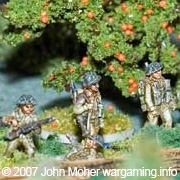 Kieran and I decided to play another “Hit The Dirt” scenario, and at the same time introduce another Auckland Wargaming Club member, Ben, to Crossfire. We selected ‘Reconnaissance Before Pontecorvo‘ (May 1944), as a suitable scenario that matched our available forces on the day and kept the size of the game to manageable with a new player.
Kieran and I decided to play another “Hit The Dirt” scenario, and at the same time introduce another Auckland Wargaming Club member, Ben, to Crossfire. We selected ‘Reconnaissance Before Pontecorvo‘ (May 1944), as a suitable scenario that matched our available forces on the day and kept the size of the game to manageable with a new player.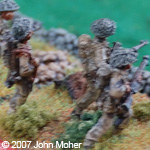 Kieran and I have had copies of “Hit The Dirt” for sometime (in fact I have had a copy since it was published) and had not made a serious attempt to play any of the scenarios. However we recently decided to work our way through the book and play the scenarios as best we could with our available forces. Deciding to start from the beginning we selected Green Hell, the very first Scenario in the book. In Green Hell a well supported German Company must overcome a larger (but poorer) Soviet Force in a large forest in Poland in 1941. Our troop availability (at the time) dictated a move to 1944 and North-West Europe or Italy (we chose the former) with British and German forces.
Kieran and I have had copies of “Hit The Dirt” for sometime (in fact I have had a copy since it was published) and had not made a serious attempt to play any of the scenarios. However we recently decided to work our way through the book and play the scenarios as best we could with our available forces. Deciding to start from the beginning we selected Green Hell, the very first Scenario in the book. In Green Hell a well supported German Company must overcome a larger (but poorer) Soviet Force in a large forest in Poland in 1941. Our troop availability (at the time) dictated a move to 1944 and North-West Europe or Italy (we chose the former) with British and German forces.
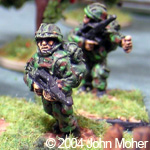 Hypothetical 1993 NATO exercise with reinforced British Para Company clearing a village held by a reduced German Panzer Grenadier Company.
Hypothetical 1993 NATO exercise with reinforced British Para Company clearing a village held by a reduced German Panzer Grenadier Company.